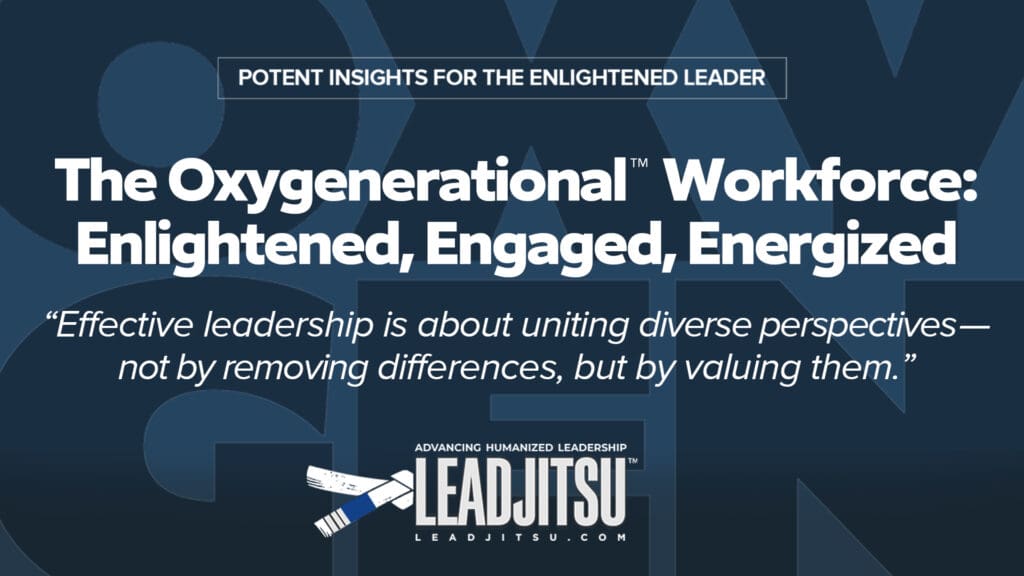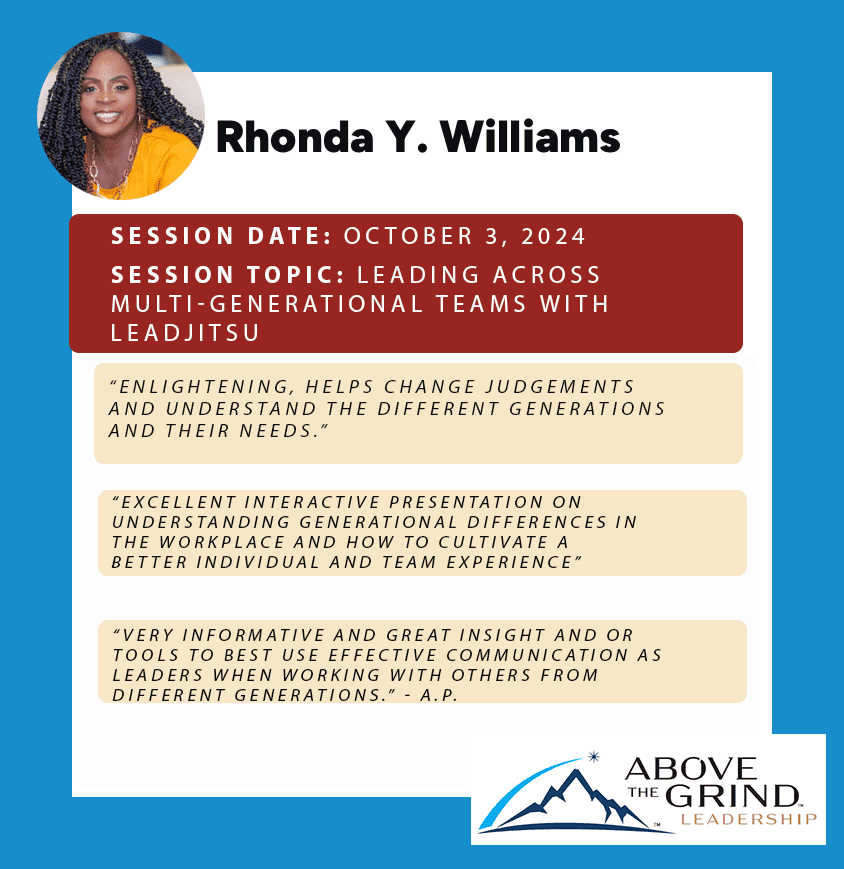The workplace is no longer defined by a single, homogeneous group—it’s now a blend of multiple generations, each with unique experiences, values, and perspectives. But as we move beyond the notion of a “multigenerational workforce,” there’s an emerging concept that goes further: the Oxygenerational Workforce. This term encapsulates a workspace that isn’t just inclusive of different generations but is revitalized by them—a collective that breathes new life into the organization through shared purpose, mutual respect, and collaborative energy. At LEADJITSU, we believe this shift is both essential and transformative, creating a more resilient, innovative, and thriving work environment.
Let’s explore how the principles of LEADJITSU support the Oxygenerational concept, offering a pathway for leaders to foster this dynamic, renewed workplace.

Why Move from Multigenerational to Oxygenerational?
A multigenerational workforce brings together Baby Boomers, Gen X, Millennials, and Gen Z, each offering distinct perspectives. However, the term “multigenerational” can imply division rather than unity, focusing more on the age gaps than on the collaborative potential. In contrast, an Oxygenerational workplace is about creating an environment where these generations don’t just coexist—they thrive together by drawing on each other’s strengths, reinvigorating the workplace with fresh ideas, and building resilience through collective understanding.
An oxygenerational approach embraces the notion of renewal and adaptability. It recognizes that each generation brings something valuable and that blending these insights creates a richer, more agile organization capable of evolving with the times.
LEADJITSU Principles for Building an Oxygenerational Workforce
To bring this concept to life, leaders need a framework that empowers them to harness the potential of all generations. LEADJITSU’s principles offer a unique approach to fostering collaboration, empathy, and purpose, turning generational differences into opportunities for growth.
1. Dojo Respect: Cultivating Mutual Respect Across Generations
At the heart of an oxygenerational workforce is Dojo Respect—the practice of valuing every individual’s experience, perspective, and contributions. In a dojo, every participant is treated with honor and regard, regardless of rank or background. Similarly, in the workplace, Dojo Respect means that every generation’s voice is not only heard but also valued.
How Leaders Can Apply Dojo Respect:
- Facilitate Cross-Generational Dialogue: Create regular opportunities for team members from different generations to share their experiences, insights, and challenges.
- Celebrate Diverse Perspectives: Highlight the unique contributions each generation brings to the team, fostering a sense of shared purpose and belonging.
Dojo Respect cultivates an environment where team members see themselves as integral parts of a larger mission, leading to a collaborative and resilient workplace culture.
2. Gi Integrity: Building a Foundation of Trust and Accountability
For an oxygenerational workforce to flourish, Gi Integrity—or ethical conduct and honesty—is essential. When leaders demonstrate integrity, it sets a standard of trust, which is crucial for uniting individuals with diverse backgrounds and values. Each generation holds different expectations around communication and leadership, so a commitment to integrity helps bridge these expectations by establishing a culture of openness and consistency.
Enter the Generational Leadership Dojo – Essential Training for Leaders
In today’s workforce, success isn’t just about managing teams—it’s about creating harmony across generations. The LEADJITSU Multi-Generational Leadership Workshop is a powerful, interactive experience designed to bridge the gap between Baby Boomers, Gen X, Millennials, and Gen Z. This 2.5-hour workshop equips leaders with the tools to foster respect, inclusion, and clear communication across generations.
Through practical exercises and the LEADJITSU Leader’s Code, your team will learn how to leverage generational diversity for innovation, collaboration, and sustained success. It’s time to move beyond generational divides and unite your team with a shared vision.
Empower your team to thrive together. Let’s build a future where every generation contributes to creating a dynamic and inclusive workplace.
Schedule a complimentary consultation today.

How Leaders Can Apply Gi Integrity:
- Transparent Decision-Making: Clearly explain decisions and invite feedback, ensuring everyone feels respected and informed.
- Model Ethical Standards: Show consistency in actions and decisions, setting a precedent that builds trust across all generations.
Gi Integrity encourages employees to feel secure and aligned with organizational goals, knowing they’re part of a trustworthy environment.
3. Flow Adaptability: Embracing Flexibility to Meet Generational Needs
In an oxygenerational workplace, adaptability is essential. Flow Adaptability involves adjusting leadership styles and communication methods to suit the varied preferences of each generation. By understanding and honoring each generation’s preferred way of working, leaders can create an environment where team members feel comfortable and empowered to contribute.
How Leaders Can Apply Flow Adaptability:
- Personalize Communication: Be mindful of generational preferences, whether that’s through digital platforms, face-to-face interactions, or blended communication methods.
- Encourage Flexibility: Allow teams to find rhythms that work best for them, whether through remote work options, flexible schedules, or project approaches.
Flow Adaptability helps teams stay resilient in the face of changing circumstances and supports each generation’s unique approach to work.
4. Sensei’s Humility: Learning Together, Growing Together
To create an oxygenerational environment, leaders must embrace Sensei’s Humility—a commitment to lifelong learning and openness to feedback. This principle encourages leaders to recognize that they don’t have all the answers and that each generation brings insights that can drive the team forward. By promoting a culture of humility, leaders model a growth mindset, inviting contributions from all team members and encouraging everyone to learn from one another.
How Leaders Can Apply Sensei’s Humility:
- Seek Input from All Levels: Encourage team members to share their knowledge and insights, regardless of seniority or age.
- Lead by Example: Show openness to learning and adapting, demonstrating that growth is an ongoing journey for everyone.
Sensei’s Humility helps eliminate hierarchy in knowledge-sharing, allowing younger and older generations to learn from each other and innovate together.
LEADJITSU-Inspired Activities for Fostering an Oxygenerational Workplace
Activity 1: Generational Insights Circle
Create a monthly “Generational Insights Circle” where team members from different generations can share personal experiences, work values, and expectations. This circle promotes mutual respect and builds understanding of generational perspectives, reinforcing Dojo Respect.
Activity 2: Adaptive Collaboration Sessions
Hold regular “Adaptive Collaboration” sessions where team members work together to solve a problem or innovate a process, using diverse communication styles and tools. This exercise supports Flow Adaptability by encouraging team members to be flexible and open to new ways of working.
Conclusion: The Oxygenerational Advantage
Shifting from a multigenerational to an oxygenerational workforce isn’t just about coexisting; it’s about thriving through generational diversity. By adopting LEADJITSU’s principles—Dojo Respect, Gi Integrity, Flow Adaptability, and Sensei’s Humility—leaders can create an environment that values every generation’s contributions, fueling a workplace that’s not only collaborative but also renewed and energized.
When leaders embrace an oxygenerational mindset, they unlock a new level of innovation, engagement, and resilience. This approach doesn’t merely bridge generational divides—it leverages them, creating a workplace where every team member, regardless of generation, can breathe life into the organization’s mission.


